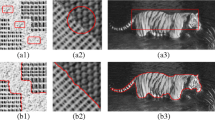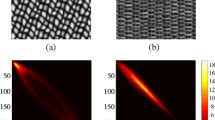Abstract
Extracting textured objects from natural scenes is a challenging task in computer vision. The main difficulties arise from the intrinsic randomness of natural textures and the high-semblance between the objects and the background. In this paper, we approach the extraction problem with a seeded region-growing framework that purely exploits the statistical properties of intensity inhomogeneity. The pixels in the interior of potential textured regions are first found as texture seeds in an unsupervised manner. The labels of the texture seeds are then propagated through their respective inhomogeneous neighborhoods, to eventually cover the different texture regions in the image. Extensive experiments on a large variety of natural images confirm that our framework is able to extract accurately the salient regions occupied by textured objects, without any complicated cue integration and specific priors about objects of interest.
Access this chapter
Tax calculation will be finalised at checkout
Purchases are for personal use only
Preview
Unable to display preview. Download preview PDF.
Similar content being viewed by others
References
Julesz, B.: Textons, the elements of texture perception and their interactions. Nature 290, 91–97 (1981)
Chen, C., Pau, L.: Texture analysis. In: Wang, P.S.P. (ed.) The Handbook of Pattern Recognition and Computer Vision, 2nd edn., ch. 2.1, pp. 207–248. World Scientific Publishing Co., Singapore (1998)
Varma, M., Zisserman, A.: A statistical approach to texture classification from single images. International Journal of Computer Vision 62(1-2), 61–81 (2005)
Deng, Y., Manjunath, B.S.: Unsupervised segmentation of color-texture regions in images and video. IEEE Transactions on Pattern Analysis and Machine Intelligence 23(8), 800–810 (2001)
Alpert, S., Basri, M., Brandt, A.: Image segmentation by probabilistic bottom-up aggregation and cue integration. In: International Conference on Computer Vision and Pattern Recognition, pp. 1–8 (2007)
Liang, K., Tjahjadi, T.: Adaptive scale fixing for multiscale texture segmentation. IEEE Transactions on Image Processing 15(1), 249–256 (2006)
**a, Y., Feng, D., Zhao, R.: Morphology-based multifractal estimation for texture segmentation. IEEE Transactions on Image Processing 15(3), 614–623 (2006)
**ang, S., Nie, F., Zhang, C.: Texture segmentation: An interactive framework based on adaptive features and transductive learning. In: Narayanan, P.J., Nayar, S.K., Shum, H.-Y. (eds.) ACCV 2006. LNCS, vol. 3851, pp. 216–225. Springer, Heidelberg (2006)
Paragios, N., Deriche, R.: Geodesic active regions and level set methods for supervised texture segmentation. International Journal of Computer Vision 46(3), 223–247 (2002)
Nock, R., Nielsen, F.: Statistical region merging. IEEE Transactions on Pattern Analysis and Machine Intelligence 26(11), 1452–1458 (2004)
Sharon, E., Galun, M., Sharon, D., Basri, R., Brandt, A.: Hierarchy and adaptivity in segmenting visual scenes. Nature 442(7104), 810–813 (2006)
Suyash, P., Awate, T.T., Whitaker, R.T.: Unsupervised texture segmentation with nonparametric neighborhood statistics. In: Leonardis, A., Bischof, H., Pinz, A. (eds.) ECCV 2006. LNCS, vol. 3952, pp. 494–507. Springer, Heidelberg (2006)
Ding, J., Ma, R., Chen, S.: A scale-based coherence connected tree algorithm for image segmentation. IEEE Transactions on Image Processing 17(2), 204–216 (2008)
Author information
Authors and Affiliations
Editor information
Editors and Affiliations
Rights and permissions
Copyright information
© 2010 Springer-Verlag Berlin Heidelberg
About this paper
Cite this paper
Ding, J., Shen, J., Pang, H., Chen, S., Yang, J. (2010). Exploiting Intensity Inhomogeneity to Extract Textured Objects from Natural Scenes. In: Zha, H., Taniguchi, Ri., Maybank, S. (eds) Computer Vision – ACCV 2009. ACCV 2009. Lecture Notes in Computer Science, vol 5996. Springer, Berlin, Heidelberg. https://doi.org/10.1007/978-3-642-12297-2_1
Download citation
DOI: https://doi.org/10.1007/978-3-642-12297-2_1
Publisher Name: Springer, Berlin, Heidelberg
Print ISBN: 978-3-642-12296-5
Online ISBN: 978-3-642-12297-2
eBook Packages: Computer ScienceComputer Science (R0)




